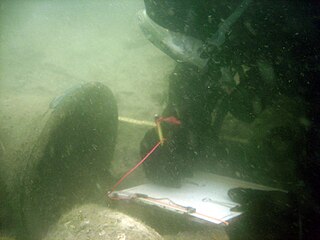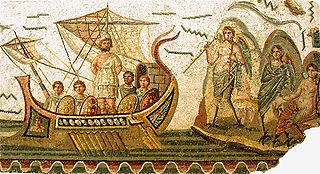
Maritime archaeology is a discipline within archaeology as a whole that specifically studies human interaction with the sea, lakes and rivers through the study of associated physical remains, be they vessels, shore-side facilities, port-related structures, cargoes, human remains and submerged landscapes. A specialty within maritime archaeology is nautical archaeology, which studies ship construction and use.

A shipwreck is the wreckage of a ship that is located either beached on land or sunken to the bottom of a body of water. Shipwrecking may be intentional or unintentional. There were approximately three million shipwrecks worldwide as of January 1999, according to Angela Croome, a science writer and author who specialized in the history of underwater archaeology.

Metacomet, also known as Pometacom, Metacom, and by his adopted English name King Philip, was sachem to the Wampanoag people and the second son of the sachem Massasoit. Metacom became sachem in 1662 when his brother Wamsutta died shortly after the death of their father. Wamsutta's widow Weetamoo, sachem of the Pocasset, was Metacom's ally and friend for the rest of his life. Metacom married Weetamoo's younger sister Wootonekanuske. It is unclear how many children they had or what happened to them. Wootonekanuske and one of their sons were sold to slavery in the West Indies following the defeat of the Native Americans in what became known as King Philip's War.

The second USS Conestoga (SP-1128/AT-54) was an ocean-going tug in the United States Navy. Commissioned in 1917, it disappeared in the Pacific Ocean in 1921. The fate of the vessel was a mystery until its wreck was positively identified in 2016.

Brother Jonathan was a paddle steamer that struck an uncharted rock near Point St. George, off the coast of Crescent City, California, on July 30, 1865. The ship was carrying 244 passengers and crew, with a large shipment of gold. Only 19 people survived, making it the deadliest shipwreck up to that time on the Pacific Coast of the United States. Based on the passenger and crew list, 225 people are believed to have died. Its location was not discovered until 1993 and a portion of the gold was recovered in 1996. The ship was also instrumental in setting off the 1862 Pacific Northwest smallpox epidemic, which killed thousands of Indigenous people in the region.

Hereward, was British clipper ship that was built in Scotland in 1877. She had an iron hull, three masts and full rig.

SS Winfield Scott was a sidewheel steamer that transported passengers and cargo between San Francisco, California and Panama in the early 1850s, during the California Gold Rush. After entering a heavy fog off the coast of Southern California on the evening of December 1, 1853, the ship crashed into Middle Anacapa Island. All 450 passengers and crew survived, but the ship was lost.

The archaeology of shipwrecks is the field of archaeology specialized most commonly in the study and exploration of shipwrecks. Its techniques combine those of archaeology with those of diving to become Underwater archaeology. However, shipwrecks are discovered on what have become terrestrial sites.

James Preston Delgado is a maritime archaeologist, historian, maritime preservation expert, author, television host, and explorer.

HMS Buffalo was a storeship of the Royal Navy, originally built and launched at Sulkea, opposite Calcutta, in 1813 as the merchant vessel Hindostan. The Admiralty purchased her that year after she arrived in Britain. She later transported convicts and immigrants to Australia, before being wrecked in 1840.

Queen of Nations was a wooden-hulled, three-masted clipper that was built in Scotland in 1861 and wrecked on the coast of New South Wales in 1881. She spent her entire two-decade career with George Thompson, Junior's Aberdeen White Star Line.

Loch Vennachar was an iron-hulled, three-masted clipper ship that was built in Scotland in 1875 and lost with all hands off the coast of South Australia in 1905. She spent her entire career with the Glasgow Shipping Company, trading between Britain and Australia. The company was familiarly called the "Loch Line", as all of its ships were named after Scottish lochs. The ship was named after Loch Venachar, in what was then Perthshire.

The SS Monte Carlo was a concrete ship launched in 1921 as the oil tanker SS Old North State. She was later renamed McKittrick. In 1932 she became a gambling and prostitution ship operating in international waters off the coast of Long Beach, California, United States, and was relocated to Coronado, California in 1936. The Monte Carlo was grounded on Coronado Island on New Year's Day 1937 during a storm and her wreck remains on the beach.
Carrier Pigeon was an American clipper ship that was launched in the fall of 1852 from Bath, Maine. Her value was estimated at US$54,000. She was wrecked on her maiden voyage off the north coast of what was then Santa Cruz County in the state of California.
Many ships have wrecked in and around San Francisco Bay. For centuries San Francisco Bay, with its strong currents, rocky reefs, and low fog conditions has experienced more than a hundred shipwrecks. Ever since San Francisco Bay was discovered during the land expedition of Gaspar de Portolà in 1769, it has been one of the most popular harbors.

Discovered by divers from the French Navy Diving School in 1967, the archaeological investigations of the Roman wreck at Madrague de Giens constituted the first large scale, "truly scientific underwater excavation[s] carried out in France". The wreck lies at around 18 to 20 metres depth off the coast of the small fishing port of La Madrague de Giens on the Giens Peninsula, east of Toulon, on the southern Mediterranean coast of France. Sunk around 75–60 BCE, the vessel has been found to be "a large merchantman of considerable tonnage—400 tons deadweight with a displacement of around 550 tons", making it one of the largest Roman wrecks excavated, with only the wreck at Albenga, Italy exceeding it at the time of its discovery. The vessel wrecked at Madrague de Giens measured around 40 metres in length; "showed a sharp bottom with "wine glass" section and a prominent keel creating a large leeboard"; displayed extended raking of the stem and stern; and had two masts. The hull was characterised by a reverse stempost in the shape of a ram with a big cutwater which "must have given... [the] craft high-performance sailing qualities". The ship sunk while transporting a large cargo of wine and black glazed pottery from Italy. It is not known why it sank.

The SS City of Chester was a steamship built in 1875 that sank after a collision in a dense fog with SS Oceanic at the Golden Gate in San Francisco Bay on August 22, 1888. She was owned by the Oregon Railroad Co. and leased by the Pacific Coast Steamship Company.

Recreational dive sites are specific places that recreational scuba divers go to enjoy the underwater environment or for training purposes. They include technical diving sites beyond the range generally accepted for recreational diving. In this context all diving done for recreational purposes is included. Professional diving tends to be done where the job is, and with the exception of diver training and leading groups of recreational divers, does not generally occur at specific sites chosen for their easy access, pleasant conditions or interesting features.

The S.S. Golden Gate was a mail and passenger steamer that operated between San Francisco and Panama City from 1851 to 1862. On its last voyage from San Francisco it caught fire and was destroyed with the loss of 204 lives off Manzanillo, Colima, Mexico. The ship was carrying $1,400,000 in gold coins for Wells Fargo, as well as large amounts of gold and coins for the passengers. Much of this was retrieved, but amateurs continue to search for gold with metal detectors on what is now called the Playa de Oro.





















